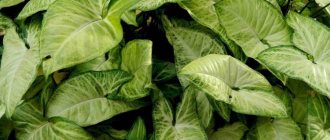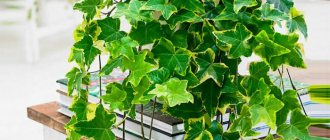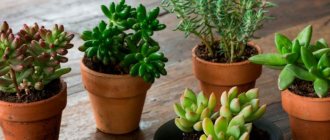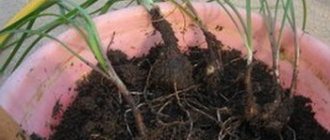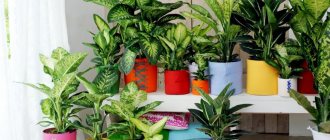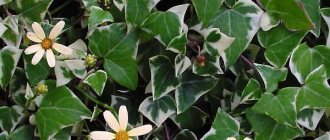Syngonium, which belongs to the lianas, is distinguished by its species diversity, different leaf shapes and colors. It is the variety of its forms that allows you to introduce novelty into the interior of the room. Syngonium can be grown as an ampelous plant in a hanging pot or you can install a support for it, along which the shoots will twine and grow in height. Caring for syngonium at home is quite simple.
Description
Syngonium belongs to the Araceae family. This evergreen vine grows in the tropical forests of Central and South America. Its flexible stem wraps around tropical trees and stretches upward. Under natural conditions, syngonium reaches ten to twenty meters. At home, it grows up to one and a half to two meters. Over the course of a year, the height of the shoots increases by thirty centimeters, forming six to seven new leaves. On the shoots, leaves on long petioles are located in convex nodes. At the nodes you can see aerial roots, with the help of which the vine clings to the support.
The leaves are bright green in color and have a heart-shaped or palmately divided blade. Relief veins are visible in the center and along the edge. The leaves can be plain or with light streaks, with a smooth or velvety surface.
This is how syngonium blooms
Many will be surprised to learn that syngonium blooms in nature. At the end of spring, cream-colored cobs appear, which are covered with a red or pink blanket. Syngonium flowers are cross-pollinated. The fruits are small berries. They attract animals and birds, which eat the berries and disperse the seeds over long distances.
Important! The milky juice released when twigs and leaves are broken is poisonous and irritates the skin. When working with the vine, you must wear gloves and keep animals and children away from it.
Useful properties of the plant
In the house, Syngonium creates the atmosphere of a small tropical corner. Thanks to its rapid growth, this vine quickly fills the space provided to it, and many gardeners note its positive effect on the microclimate in the house. Syngonium has a beneficial effect on a person’s emotional state and the atmosphere in the room.
How does it affect the atmosphere in the house?
Despite the prevailing stereotypes, Syngonium is believed to protect family happiness. This flower is perfect for purposeful people, since, according to some opinion, thanks to its rapid growth, its owners solve all matters and problems much faster.
The strong leaves of Syngonium symbolize persistent character, the desire for development and personal growth of its owner. Tropical liana fills the space with life and energy.
Health effects
It is believed that Syngonium in the home has a beneficial effect on the human digestive system and contributes to the speedy cure of gastrointestinal diseases. By acquiring this tropical plant, many believe that illnesses will bypass them, and old diseases will soon be cured.
Effect on emotional state
Syngonium willingly shares its energy with the inhabitants of the home. If placed in the bedroom, it will help relieve tension, organize thoughts and get rid of nightmares.
The rapid growth of the plant helps its owner overcome the fear of the future, open new boundaries in communication with other people and overcome their complexes. For people with conservative views, Syngonium will give them a craving for new things, calm them down, and “teach” them loyalty and tolerance.
By transforming the shape of its leaves, Syngonium helps the owner himself to transform. It is great for creative people and intellectuals.
Types of syngonium
The Syngonium genus is divided into twenty species, but only a few of them are grown indoors. The species used in indoor floriculture include several varieties bred by botanists.
Legleaf
This species in nature has petiolate leaves reaching a length of thirteen centimeters. As they age, the lance-shaped whole leaf blades begin to separate into lobes. The number of lobes on dissected leaves can reach eleven. The leaves are located on a stalk up to sixty centimeters long.
Foot-leaved syngonium has the following popular varieties:
Panda Neon Arrow
Pixie
- Panda - distinguished by yellowish spots on dark green leaves;
- Neon - almost white leaves with pink spots and veins;
- Pixie - has short stature and variegated leaves;
- Arrow - leaves with light streaks along the veins and large shoots.
Auricular (eared)
This species got its name from the shape of the leaves, which have a pair of small leaflets on both sides from the base. On branches 2-2.5 cm thick, aerial roots are densely formed in the internodes. Leaf sizes range from six to twenty centimeters. The leaves are bright green, with shiny skin. The leaf petioles reach forty centimeters.
This may be interesting: How to overcome the difficulties of caring for Poliscias
Wendlanda
A medium-sized vine with petioles from 20 to 30 cm long, dark green leaves up to twenty centimeters. As they mature, the leaves are divided into three parts and have a velvety surface. Some varieties of Wendland syngonium have a silver-white stripe along the central vein.
Main types with photos and names
The most common species of the genus Syngonium in indoor culture are legleaf, wendlanda and auriculate. They look similar to each other during the vegetative stage of growth. Based on 3 natural species, breeders have obtained many varieties of syngonium with two-color and three-color leaves. However, the more colorful the leaves, the more sensitive the plant is to care errors. Pure green syngonium is more shade-tolerant.
Legleaf
Syngonium podophyllum cheerfully climbs up a support, elegantly hangs from a hanging flowerpot, and spreads its shoots horizontally on a window sill or table. The type of growth depends on where you place the indoor flower and whether you prune it.
Description of S. podophyllum:
- Young stems are slightly fleshy, smooth, and often contain milky juice.
- Old stems are pale brown, slightly woody.
- Aerial roots grow at the nodes.
- Young leaves are large, arrow-shaped or heart-shaped, solid dark green or with silver-white streaks and spots.
- Older leaves are usually divided into three segments or 5–11 individual leaflets.
- The inflorescence is an elongated white spadix surrounded by a creamy white or greenish spathe (modified leaf).
- The fruits are red at first, then turn brown.
- The seeds are small black or brown.
If you notice a flower on your indoor plant Syngonium podophyllum, you can be proud of yourself. Only mature specimens bloom in the room and are well cared for. The flowers are quite modest, inferior in beauty to the leaves.
Auriculate
The indoor flower is also called “syngonium auricular.” There are several variants of the species epithet in the Latin name of the plant: auricularis, auritum, auricle.
Syngonium auricularis is a liana with thin graceful stems 1.8 m long. The leaves are dense and glossy. Near the base there are processes of the leaf blade - “ears”, thanks to which the species name appeared. The general background is dark green, the veins are lighter, almost white. The shape of the leaves changes with age: first arrow-shaped, then 3–5 palmate.
Wendlanda
Syngonium wendlandii is a slow-growing vine. The leaves are spear-shaped, velvety, dark green in color, more elongated than those of S. legifolia. At the base of the plate, 2 wider ears are formed than in S. auricularis; the main part, which has an oval shape, is directed forward. Light-colored central vein, sometimes silvery.
There are many varieties created based on 3 types of syngonium. The care requirements are largely similar. Only you need to take into account the characteristics of variegated (variegated, spotted) plants. They are more sensitive to location and amount of light.
Rules of care
Caring for syngonium at home is not difficult. Therefore, in many offices and apartments you can find various varieties of this vine.
Lighting
Syngonium, growing in its homeland in the shade of tropical trees, does not like direct sunlight. Therefore, it is better to place it on a western or eastern window. On the south side, the vine is placed away from the window. In the autumn-winter period, when plants lack light, it is recommended to place the pot closer to the light or organize additional lighting. Otherwise, the leaves begin to turn pale, and variegated leaves lose color.
Temperature
Syngonium is well adapted to indoor conditions. In summer, it feels comfortable in a temperature range of 20 to 25 degrees. In winter, it is advisable to maintain it at a temperature of 18 to 20 degrees. Liana can survive a drop in air temperature of up to ten degrees, but only for a short time. It should be noted that in winter it is necessary to protect the syngonium from the effects of dry air from heating devices and radiators. They also protect the plant from drafts, otherwise the plant weakens and is susceptible to disease.
Watering and moistening
Syngonium, as a resident of the tropics, is accustomed to humidity. Therefore, it is often and abundantly watered as the top layer of soil dries. The water should be settled, soft and at room temperature. After watering, the remaining water is poured out of the pan.
In summer, the vine needs additional moisture by spraying with settled or boiled water at room temperature. In hot weather, it is advisable to spray daily. In summer, you can additionally give the plant a shower, but only with boiled water. It is also recommended to place containers of water next to the plant or place the pot on wet expanded clay. But at the same time, the pot should not stand in the water or touch it, otherwise the roots will rot.
In winter, showers are replaced by wet wiping of leaves. And watering is carried out less frequently - two to three days after the top layer has dried. If a plant lacks moisture, the tips of its leaves begin to dry out and “rusty” spots appear. If over-watered, the leaves become dull. Increased air humidity in the room is manifested by droplets of moisture at the tips of the leaves.
Soil and fertilizing
The soil for the syngonium is prepared loose and breathable. You can buy a ready-made earthen mixture for Aroids. It is advisable to add coconut fiber to it in a small amount to give it looseness. It’s easy to prepare the mixture yourself. To do this you need to take the following ingredients in equal parts:
- leaf soil;
- turf land;
- peat;
- sand.
This may be interesting: Caring for arrowroot at home
In spring and summer, decorative deciduous indoor plants are fertilized with mineral fertilizers.
Note! It is necessary to take fertilizer with a small amount of calcium.
Fertilizing is done twice a month. In winter there is no need to feed syngonium. But if in winter the leaves of syngonium begin to turn yellow, then you can carry out a one-time fertilizing to replenish nutrients.
Transfer
In the spring, the vine is transplanted into a larger pot. Young plants need to be replanted every year, and adults - once every two to three years. If the roots are peeking out of the holes in the bottom of the pot, then the plant needs to be replanted. When planting, a good layer of drainage is poured onto the bottom. An adult plant is transplanted using the transshipment method, leaving soil on the roots.
If it is assumed that the plant will grow vertically, then when replanting, first place a support and strengthen it with expanded clay, a layer of earth, and then plant the plant. When replanting, dried leaves and shoots are removed, and decorative rejuvenation of the bush is carried out.
Formation of syngonium when caring at home and how to pinch the crown (with video)
As shown in the photo, depending on the variety, the syngonium is held as an hanging plant or tied to a support:
The formation of syngonium at home depends on the method of planting and care. If a grower wants to grow a climbing flower, he will need support and a drainage layer in the substrate so that the roots have something to hold on to. For the first, a plastic or wooden tube fixed in a pot is suitable.
You can decorate it with moss, which grows well in high humidity conditions, or with fabric that retains moisture. As it develops, the stem will beautifully wrap around the proposed support. A hanging plant requires the stems to be able to hang freely, so you can plant several cuttings in a hanging pot.
There are also varieties of syngonium that are short-growing and compact, for example, Arrow or Brocant: it is better to plant them in spacious boxes or bowls.
Important! It grows better in spacious shallow pots than in deep ones.
Proper care of syngonium at home includes the formation of the crown. Firstly, it facilitates the growth of the plant, which tends to stretch out greatly and make the support heavier; secondly, this allows you to emphasize its decorative properties, giving the plant the desired shape.
Fast growth and high adaptive abilities allow you to see the results of the grower’s efforts and correct possible mistakes in the shortest possible time. In addition to using supports with transverse bars around which the vine will curl, there is a more popular way to form a syngonium - pinching.
The method for pinching syngonium is no different from the methods used for other plants - using a knife or sharply sharpened scissors, the apical buds and/or buds located at the ends of the side shoots are removed. It is considered optimal to pinch the sprouts over every sixth leaf.
Carefully! Contains substances that irritate the skin and mucous membranes. All manipulations that injure plants are performed with gloves.
The video shows in detail how to pinch syngonium correctly:
Syngonium propagation
Syngonium easily propagates vegetatively. For this, apical cuttings or shoots are used, the length of which should be about ten to fifteen centimeters.
There must be at least two buds on the shoot for propagation.
Cuttings are cut in the spring, which allows the mother plant to send out lateral branches. Rooting of cuttings is carried out in water or soil mixture. It is recommended to add an activated carbon tablet to the rooting water for disinfection.
You can prepare a mixture for rooting cuttings by choosing one of the following compositions:
- peat and sand;
- peat and vermiculite;
- sphagnum moss and sand;
- sand.
The end of the cutting is immersed a couple of centimeters in the wet mixture, having first sprinkled the cut with a growth stimulator. The cuttings are covered with a transparent bag with holes made for ventilation. The container is placed in a room with a temperature of 24 to 27 degrees.
When the cuttings take root, they are planted in a pot. A layer of expanded clay is poured onto the bottom, and the prepared earthen mixture is sprinkled on top. If the cuttings are planted one at a time, then a container with a diameter of seven to nine centimeters is suitable. Planting multiple cuttings together will require a larger pot. Then they lower the cutting, carefully straightening the roots and sprinkling them with soil. The soil on top is lightly compacted. After planting is completed, water with a small amount of water. You can feed it after a couple of weeks.
The planting method is chosen based on how the plant is intended to be grown. Several cuttings are planted when you want the syngonium to grow as a compact bush . To obtain a climbing vine, one cutting is planted, having previously placed a support and strengthened it in the drainage, sprinkled with earth. It is recommended to wrap the support with coconut fiber or sphagnum moss. This will allow the aerial roots to gain support. To increase the humidity around the vine, we recommend moistening the moss on the support with water.
As young shoots grow, they are pinched above the sixth leaf, which causes the plant to send out side shoots.
To obtain decorative compositions, it is recommended to plant cuttings of different varieties, with leaves of different shapes and different colors, in one container (pot, flower box).
Varietal diversity
Variegated or variegated varieties of syngonium (as in the photo) are the most popular.
Variegation means “variegation” in Latin. The reason for the appearance of colored spots and stripes on the leaves is a lack of chlorophyll caused by a mutation. Varietal syngoniums "Albo Variegata" - with white-green leaves, "Aurea Variegata" - with yellow-green leaves. The color of the leaves of the Tricolor syngonium varieties combines green, white, cream, yellow, and pink tones.
Examples of varieties:
- Syngonium "Tiffany" - with pink spots collected in the center of the leaf blade.
- “Jade” is two-color (white and green). The spots are scattered unevenly.
- "Spear point" - with spear-shaped or arrow-shaped leaves. The creamy white color seems to “spread” from the central vein to the edges of the leaf blade.
- "Aron Brown" is a syngonium with triangular-rounded leaves. The color contains green and chocolate tones.
- "Alyuzhn" - with rounded heart-shaped leaves. The main color is olive green (“Mango Aluzhn”) or golden (“Gold Aluzhn”).
Spear point variety
Syngonium "Neon"
'Neon Pink' features creamy pink, heart-shaped leaves with a light green edge.
In everyday life, the variety is called for short - “Syngonium Neon”. Additional words in the name - “robusta”, “tetra”, etc. - describe differences in color. For example, the Syngonium variety "Neon robusta" has light pink leaves.
Syngonium "Panda"
A fast-growing variety characterized by a bushy form. This cultivar owes its name to the white or light yellow spots, specks, and streaks on the matte dark green leaves.
"Imperial White"
"Imperial White" is an almost white-leaved variety with small areas colored green and light green.
Such a syngonium is more difficult to propagate, and difficulties arise during care. If there is a lack of nitrogen in the soil, the interesting color is lost; if there is too much, the leaves will fall off.
Syngonium "Pixie"
'Pixie' is a miniature variety with green and white leaves. It grows slowly and remains compact.
Very convenient for small spaces. Pixie syngoniums are becoming increasingly sought after by collectors.
Syngonium "Pink"
“Pink” is a very decorative pink syngonium. This variety is grown as a bush or vine. With age, the color becomes paler. Syngonium "Pink spot" is fast growing. The leaves are creamy pink with crimson speckles when young.
'Pink Splash' is a variety whose leaves look like they've been splashed with pink paint.
"Regina ed"
Low syngonium with densely leafy shoots. The leaves are pink at the top and green at the bottom. With a lack of light, the spectacular coloring is lost.
A similar variety with pink leaves is “Aurora”. Syngonium "Red Spot" is suitable even for those who have little space in the room. The height of the plant is about 50 cm. The color of the leaves is pink, green and brown.
Syngonium "Confetti"
“Confetti trikolor” is a rare variety that stands out for its original color. The leaves are light green with pink and yellow specks, dots, and splashes. Depending on age, the size and shape of leaf blades change.
"Butterfly"
Syngonium "Butterfly" has arrow-shaped leaves with white-green streaks, reminiscent of a marble pattern. The popular variety “White Butterfly” or “White Butterfly” reaches a length of up to 1.5 m.
The leaves are arrow-shaped, light in the vein area, green along the edge of the blade. Unpretentious, fast-growing syngonium.
"Christmas"
A liana with spear-shaped leaves typical of Syngonium podophyllum. The Christmas syngonium looks very festive. The color of the leaf blade intricately combines green, light green, pink and cream tones.
Syngonium "Brocant"
"Brocante" is a variety whose color is compared to chocolate. The leaves are dense, green-brown. Against the general dark background of the leaf blade, brightly colored veins stand out - red, pink, cream. The surface of the leaves is glossy.
Syngonium "Arrow"
"Arrow" or "Strela" is a classic variety with spear-shaped leaves. An undemanding, fast-growing cultivar of syngonium. The leaves are emerald green with creamy white veins.
Diseases and pests
Syngonium does not require special attention when grown indoors, but if it is poorly cared for, the plant begins to have problems. Let's figure out what mistakes lead to loss of decorativeness and wilting of the vine.
- If the plant lacks light, the leaves turn pale and the shoots become elongated.
- Slow growth and small leaf sizes are due to lack of nutrients. Therefore, the plant needs to be replanted in fresh soil in the spring, and fed with mineral fertilizers in the summer.
- Leaves wither when the soil is wet - this indicates waterlogging and rotting of the roots. It will no longer be possible to save the entire plant. You need to find healthy cuttings and root them.
- The tips of the leaves and aerial roots dry out - the problem is the low humidity of the surrounding air.
- Brown spots on the leaves are caused by direct sunlight. It is necessary to move the vine to another place or shade it from the rays.
This may be interesting: Yucca - reproduction, diseases and pests
The main pests that attack the syngonium are: aphids, scale insects, spider mites, thrips.
Aphid
The small green insects form large colonies, making them easy to spot. They suck the juice from the plant, which leads to the withering of leaves and shoots.
Shchitovka
Its size is about five millimeters. If the movement of reddish, brown spots with a waxy coating is noticeable on the plant, then this is a colony of scale insects. They can be found not only on leaves, but also on shoots. Young individuals crawl from place to place, and adult scale insects gather in colonies to reproduce. The result of their activity is drooping, withering shoots and leaves.
Trips
These small insects settle on the underside of the leaf and feed on plant sap. The leaf on which thrips have settled acquires a silvery sheen on the upper side, and the light dots gradually merge into gray-brown spots.
Spider mite
Its presence is noticed by the white cobwebs on the leaves and shoots. The insect has a size of up to one millimeter, an oblong body. They multiply intensively at high temperatures and low air humidity. White spots appear in areas affected by spider mites. Also, the web gradually covers the leaves and shoots.
Control measures
If the number of insects is small, then treatment with folk remedies can be used. Use rubbing, washing the leaves with a soapy solution of laundry soap, infusion of tobacco or garlic. Repeated processing will be required.
If pests have taken over a large area of the plant or folk remedies do not have the desired effect, then resort to the help of insecticides. Popular drugs are Actellik, Derris. They are used according to the instructions. Re-processing may be required.
Signs, superstitions and history of growing syngonium
During its use in indoor floriculture, syngonium has acquired a considerable number of folk signs and superstitions. Among them there are those who approve of growing vines in the house and those who advise refraining from purchasing a green pet.
Positive signs about syngonium are as follows:
- The guardian of family happiness. The flower emits positive energy and absorbs all negativity.
- The ability of a plant to transform contributes to the transformation of people. Owners of vines change for the better.
- Syngonium helps “burn bridges.” It promotes a painless parting with an unpleasant past.
- Home doctor. It is believed that the flower contributes to the speedy recovery of its owner from diseases.
- Night watchman. The plant intercepts nightmares and bad dreams, allowing the owner to enjoy healthy sleep.
The following negative signs are associated with keeping a flower in the house:
- Husbandry remedy. According to popular beliefs, the flower does its best to keep men out of its home.
- Poisonous breath. The Chinese believe that this plant poisons the lives of the rest of the household. However, it should be noted that natives of the Celestial Empire endow all plants with arrow-shaped leaves with this property.
Syngonium came to Europe from the tropics of America. The bright appearance of the flower attracted everyone's attention to it, and it soon became very popular among flower growers. The name of the plant is translated from Latin as “the union of seed and bud.” It indicates the vine’s ability to reliably hide seed embryos in the ovary.
Syngonium in the interior: photo
In phytodesign, Syngonium can be found in many applications. It fits perfectly into any interior, and thanks to the ability to grow this vine in a hanging pot, you can form a vertical green carpet or allow the flower to hang freely.
If you install a support, you can give the Syngonium almost any shape. The liana will quickly cover the surface offered to it.
Miniature varieties of Syngonium will definitely appeal to lovers of unusual indoor gardening. Dwarf varieties are perfect for decorating florariums in solo planting or as part of a composition.
In the house, Syngonium creates a unique atmosphere of warmth and comfort. This plant even brings a part of the tropical forest to an ordinary city apartment. With simple care, Syngonium will delight its owner with a graceful and elegant look all year round.
